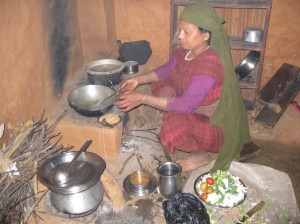Dr Colin Woodley has been to Nepal 15 times over the past six years monitoring the sponsorship of girls for their education and initiating special projects for the empowerment of women. He describes his visit to a witch doctor.
Sarita lives in a very poor mountain village in rural Nepal. I have known her mother and two sisters for many years because I am privileged to stay in their mud home during my regular 6-monthly visits.
During my recent trip Sarita shocked me. She had just visited a witch doctor to cure her jaundice. “But your teacher tells me you are very intelligent and brilliant! You love science and maths! Why do you believe?”
She replied, “Because jhankriss heals me, sometimes.”
Sarita and I are great buddies and we have heaps of laughs together so when I asked could he cure my sore, swollen ankle she said “Let’s find out!”
So we snaked down the mountain trail into the valley (2 hours) and came to his temple-like surgery where about ten women were sitting in the lotus position in a circle around him.
The witch doctor immediately beckoned me to sit down in front of him and jump the queue. I was reluctant to do this and hung back, also partly because there is no way at 74 years and nearly two meters I can sit cross-legged. I eventually manoeuvred myself into a sprawl in front of him. As I did this Sarita was laughing loudly and the waiting women joined in.
Sarita explained my problem to the witch doctor and told him that I was not prepared to eat or drink any of the potions and brews in little clay pots and dishes surrounding him. He began mumbling some mantras and then picked up a short stick and waved its feathered end over the swelling. After paying the 20 NepaIi Rupees consultation fee (= 30 cents) we left with many smiling “namastes” from the audience.
About half way up the mountain Sarita asked how my ankle was. “I think it’s changed,” I said. “It’s worse!” She laughed and in mock horror tried to push me off the trail.
There is, however, an extremely serious side to witchcraft in Nepal, predominantly practised in rural villages. This irrational practice preys upon vulnerable females in the community. This is the ugliest side to witchcraft in Nepal where innocent women, accused of practising witchcraft, are humiliated, assaulted, beaten and tortured.
Communities with a profound faith in witchcraft use it to answer problems not only relating to illness but to assign blame for disasters, sudden deaths and for a multitude of sufferings. It is all too easy to find a female scapegoat – a widow, one of a family without a male member, an abandoned or divorced woman, or a Dalit – by deeming her a witch and to blame.
For a goat or a few hundred rupees a witch doctor will name names, always a vulnerable female.
When a member of a family of rural elites comes down with, as an example, malaria, a witch is suspected to have caste a spell to cause the illness. A recent article in the Kathmandu Post reported a case as small as a bullock falling of a bridge into a creek and breaking its leg and a local female was named as the witch which caused the incident.
Witch hunting is also a powerful tool for men who wish to persecute assertive women who directly or indirectly who challenge men’s undue but traditional supremacy. This is evident in Nepali society right from birth when, if the new baby is a boy there is great celebration with gifts and partying, and if a girl, “well, maybe next time”.
Throughout childhood, male children are the ones to be educated if there is spare money in the household and the gender imbalance is cemented in so many ways throughout the formative years. In marriages, the male reigns.
Persecution of females accused of being witches is tied in essence to this patriarchal tyranny. I have personally heard, directly, so many stories of beating, assault and maltreatment of women by men because of my association in working with the poorer classes. There is a body of literature that shows a direct correlation between gender inequality and violence against women.
The saying is “educate a man and you educate a man, educate a female and you educate a family”. Each Nepali girl we educate potentially has a multiplying beneficial effect on the future families. For example, I asked Sarita later that day if she “deep down” thought my ankle and her jaundice were likely to be cured by jhankriss. “My mother strongly believes, but me? No.”
Then, after a pause: “… but, my mother really believes, and it works for her.”
CanHelp makes it possible for you to play your part in helping rectify the situation described above, in a specific instance, by sponsoring the education of a girl in Nepal. For $27 per month you receive regular letters, photos, and school reports. Or, you can make a donation to an energetic Nepali women’s small business.
You too can help, change someones life, find out how to sponsor today.




